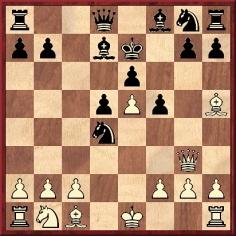
When contacting us by e-mail, correspondents are asked to include their name and full postal address and, when providing information, to quote exact book and magazine sources. The word ‘chess’ needs to appear in the subject-line or in the message itself.
| First column | << previous | Archives [37] | next >> | Current column |

Black has just played 9...Ke7, and White replied 10 Qa3 mate, which was described as an ‘airplane checkmate’ on page 292 of The Fireside Book of Chess by Irving Chernev and Fred Reinfeld (New York, 1949). Were they the inventors of that term, and how exactly might it be defined?
The position arose in a game between M. Karff and O. Lugatsch, Berlin, 1937, published on page 270 of the December 1937 Chess Review:
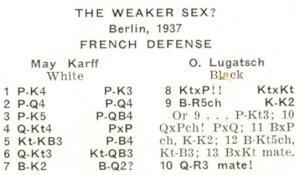
Other writers have gone their own way. Page 107 of Chess More Miniature Games by J. du Mont (London, 1953) dated the gamelet 1897, whereas on page 26 of 500 French Miniatures (Collection II) by Bill Wall (Moon Township, 1995) Black’s name was given as Lugatsca and the occasion as New York, 1938. Page 110 of The Quickest Chess Victories of All Time by Graham Burgess (London, 1998) stated that White was Karth.
When the score appeared opposite page 9 of Estrategia, 1 March 1942 (Black being ‘N.N.’) it was accompanied by this photograph of Mona May Karff:

C.N. 5080 asked whether the clock dispute in the game Capablanca v Emanuel Lasker at New York, 1924 was public knowledge before Lasker wrote about it in De Telegraaf of 3 January 1927. Luca D’Ambrosio (Bolzano, Italy) cites the following from page 74 of Deutsches Wochenschach, 30 April 1924:
‘Auffällig ist eine Mitteilung, die Dr. A. Seitz, der als Zuschauer dem Turnier beigewohnt hat, über die Partie Capablanca-Dr. Lasker macht. Danach wäre die Niederlage L’s die Folge eines Uhrendefekts. L sei infolge dieses Defekts, der zur Folge hatte, daß im kritischen Augenblick beide Uhren gingen, in Zeitnot geraten u. habe das Remis übersehen.’ [Our English translation: ‘A noteworthy report comes from Dr A. Seitz, who attended the tournament as a spectator, regarding the Capablanca-Dr Lasker game. It states that L.’s defeat was the result of a defective clock; owing to that fault, which caused both clocks to be running at the critical moment, Lasker fell into Zeitnot and overlooked the draw.’]
More generally, our correspondent refers to a sentence written by Seitz on page 146 of the May 1924 Wiener Schachzeitung:
‘Dem Turniersekretär konnte man nicht das Lob allzu großer Unparteilichkeit geben.’ [‘The tournament secretary could not be praised for excessive impartiality.’]
Finally, Mr D’Ambrosio quotes a passage from the report about New York, 1924 on page 3 of volume one of Schachjahrbuch 1924 by L. Bachmann (Ansbach, 1925):
‘Über ihre Aufnahme und ihren Aufenthalt haben sich die Turnierteilnehmer sehr günstig ausgedrückt. Selbstverständlich gab es die regelmässigen Klagen über gewisse Rücksichtslosigkeiten einzelner Meister, wie gewöhnlich so auch hier, auch fehlten nicht Beschwerden wegen Parteilichkeit des Turnierleiters von deutscher Seite.’ [‘The participants in the tournament expressed great satisfaction with their welcome and stay. Of course, there were the regular grievances about certain inconsiderate behaviour by individual masters, as is usual and as occurred here too, and there was no lack of complaints of favouritism by the tournament director, from the German side.’]
Following criticism of him in Lasker’s book Mein Wettkampf mit Capablanca (Berlin and Leipzig, 1922), a reply by Capablanca was given on pages 376-380 of the October 1922 BCM. As mentioned on page 195 of our volume on the Cuban, Lasker subsequently stated (see, for instance, page 37 of the February 1927 American Chess Bulletin) that he had submitted a response to the BCM but that it was returned to him unpublished.
Is that text of Lasker’s available anywhere?
‘Counter-attack is the best form of defence’ is a familiar chess dictum, but when was it first formulated?
The best citation we can currently offer is ‘La contre-attaque est une excellente manière de se défendre’ on page 51 of Nouveau manuel illustré du jeu des échecs by J.A. de Rivière (Paris, 1892). That was not the first edition of the book, so it may well be possible to trace the idea further back.
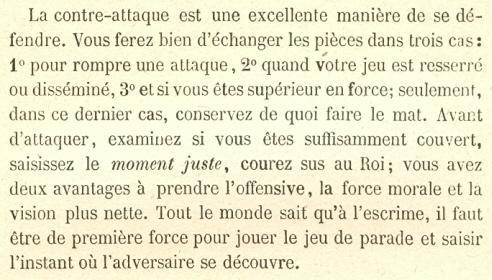
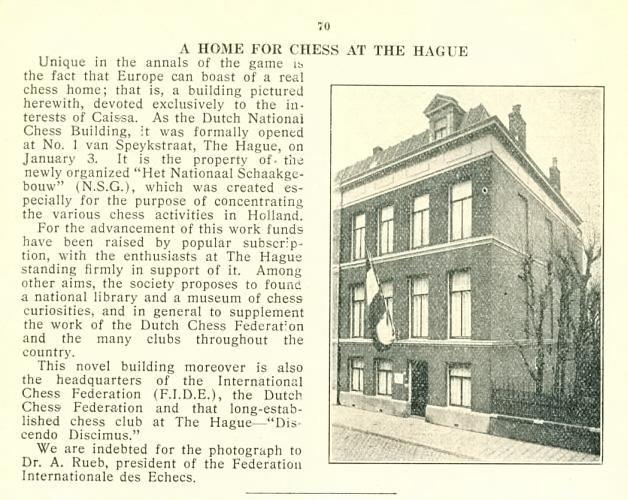
American Chess Bulletin, March 1927, page 70
Harrie Grondijs (Rijswijk, the Netherlands) has sent us the photograph below, taken on 31 July 2007:

Mark McCullagh (Belfast, Northern Ireland) notes from our Earliest Occurrences of Chess Terms article that the Oxford English Dictionary cites for ‘en passant’ a passage in Practical Chess Exercises by W.S. Kenny (London, 1818). Our correspondent quotes from page 5 (with three other instances elsewhere) of volume one of A Treatise on the Game of Chess by J.H. Sarratt (London, 1808):
‘15. A Pawn that is pushed two steps may be taken “en passant”, by the adversary’s Pawn.
N.B. This is not the case in Italy; a Pawn is allowed to pass “en prise”; and that is called “passar battaglia”.’
Anyone can sling together lists of sourceless quotes about chess, and many lackadaisical webpages do so. However, Mark N. Taylor (Mt Barry, GA, USA) points out a rare exception, PoemHunter.com, and observes:
‘The selection is small and almost entirely drawn from non-chess publications. Nonetheless, it is gratifying to see that a webmaster can do it right.’
From Fischer’s guest appearance in autumn 1972 on The Bob Hope Special television show, which also starred Mark Spitz, we have made three stills:

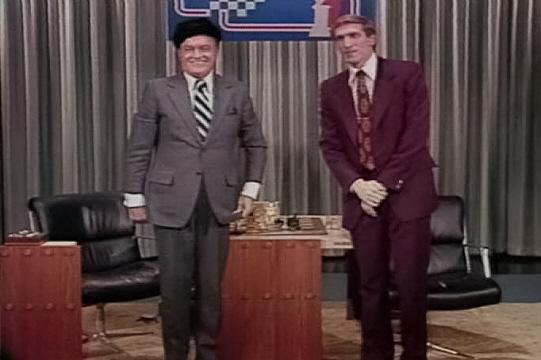
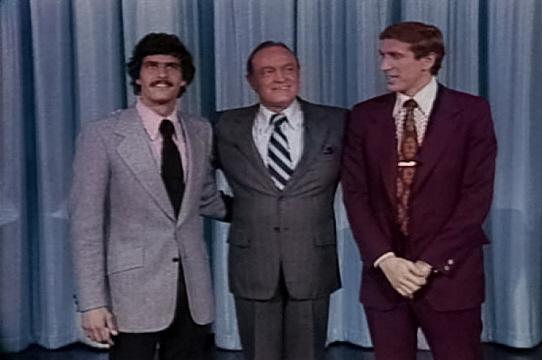
In the early part of the programme Bob Hope (‘Hopeski’) was shown enduring a lonely wait at the board. The world champion’s eventual arrival led into some rather wooden banter (naturally covering such topics as unpunctuality, cameras, noise and money), whereafter the comedian played 1 c4 and won a top-speed game during which he muddled chess and checkers and elicited the loudest possible racket from a bag of nuts.
Although the cue-cards were successfully kept off-camera, the production and editing were choppy, with, even, Hopeski’s king and queen switching places between two shots at the start of the game. The sketch lasted six minutes. Fischer received a very warm reception, although not the standing ovation accorded to Mark Spitz.
The first entry in our feature article Early Uses of ‘World Chess Champion’ is a citation for ‘Champion of the World’, with reference to Staunton, dating from 1845. Jon Crumiller (Princeton, NJ, USA) now draws attention to a passage (conveying the same concept, but without the word ‘champion’) on page 116 of The History of Chess by Richard Lambe (London, 1764):
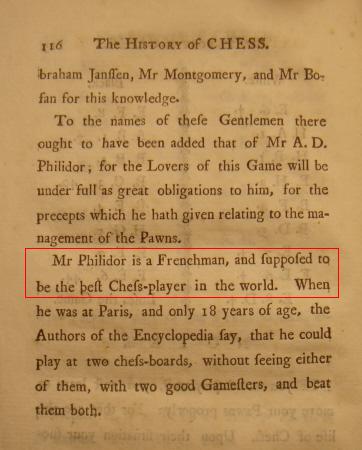
[Afterword: We have been reminded that this passage in R. Lambe’s book already appeared in C.N. 4369, courtesy of Robert John McCrary (Columbia, SC, USA).]
Mr Crumiller also refers to our feature article The Knight Challenge, which quotes chess writers’ efforts from the nineteenth century onwards to describe the knight’s move. He adds earlier examples:
Our correspondent mentions too that the description quoted in our article from Stratagems of Chess (1817) is a word-for-word copy from page 117 of Hoyle’s Games Improved (1800) and that a very similar text occurs on page 88 of R. Lambe’s The History of Chess (1764):
‘The Knights move obliquely, stepping upon every third square, including that which they quit; from black to white, and from white to black, over the heads of men, which none else do.’
C.N.s 3753 and 3800 discussed a claim that Armand Edward Blackmar composed music which was included in the film Gone with the Wind. Now Djordje Petrović (Belgrade) draws attention to an article ‘Songs of the Civil War’ by Charles Hamm. Without providing the details sought, it offers interesting background information, mentioning Gone with the Wind and Blackmar.
Luca D’Ambrosio (Bolzano, Italy) submits a further report on the dispute regarding the game Capablanca v Emanuel Lasker, New York, 1924 (from Deutsches Wochenschach, 15 June 1924, page 110):
Our translation:
‘The apparent clock defect in the Capablanca-Lasker game. Dr A. Seitz stated in his tournament reports, among personal attacks on the New York tournament director, N.L. Lederer, that Lasker’s defeat against Capablanca was due to a clock defect, as a result of which at the critical moment both clocks were running and L., who was in Zeitnot, overlooked the draw. Ignoring the personal attacks, we briefly mentioned this information on page 74 on the assumption that an explanation would not be lacking. In a communication Mr Lederer has now drawn to our attention the fact that Dr Seitz did not have access to the playing tables and therefore knew of the matter only by hearsay. “I noticed”, observes Mr Lederer in this respect, “that during the game Dr L. did not press the ‘off’ lever on his clock far enough and that both clocks were running. When play was broken off at six o’clock, we noted precisely the time difference, which was around eight minutes. It should be remarked here that Dr L. was not in Zeitnot at any time. On the contrary, before the end of play C. was in considerable Zeitnot and twice after the piece sacrifice did not make the best moves (Qf3 instead of Qe2 and Nxd6 instead of g4 [sic]). When play resumed at eight o’clock both players were, of course, out of Zeitnot, and the move which, according to Dr L.’s analysis, offered Black the prospect of a draw (Bd5 instead of Qe6) took place long after play had been interrupted ... Dr L. has, of course, never made a remark which could be interpreted as meaning that he lost the game for any reasons other than those having to do with chess, and he spoke about his opponent’s play with the greatest respect; he merely remarked that Qe6 was the losing move and that Bd5 would probably have given him a draw, and analysis will surely bring a final verdict on this.” Mr Lederer goes on to express his regret over the derisive and denigrating comments made by Dr Seitz about the committee and the tournament management, which are as unjustified as they are untrue. He says that this could cause the men whom we have to thank for the organization of the tournament not to repeat their efforts, undertaken purely in the interests of chess, if the result of their work is mean-spirited attacks by people who have enjoyed the hospitality of the Manhattan Chess Club and the Hotel Alamac. In the end, Dr Seitz was requested no longer to enter the premises of the Manhattan Chess Club.’
When the Lasker affair blew up in the United States in January 1927, Lederer wrote as follows regarding the clock incident on page 71 of the March 1927 American Chess Bulletin:

The rules for New York, 1924 were given on pages 27-28 of the
February 1924 American Chess Bulletin. The time-limit was
30 moves in the first two hours and 15 moves an hour thereafter.
The playing hours stipulated there (13.30-17.30 and 19.30-23.30)
were subsequently amended to 14.00-18.00 and 20.00-00.00 (American
Chess Bulletin, March 1924, page 49). For Capablanca’s
score-sheet of his victory over Lasker see page 80 of A
Picture History of Chess by Fred Wilson (New York, 1981).
Jan Kalendovský (Brno, Czech Republic) submits a photograph of Karel Treybal’s gravestone in Prague:

The exact location is Prague 5 – U Smíchovského hřbitova 1, Malvazinky. For information about Treybal’s death (by execution on 2 October 1941) see C.N.s 3729 and 3733.

Karel Treybal
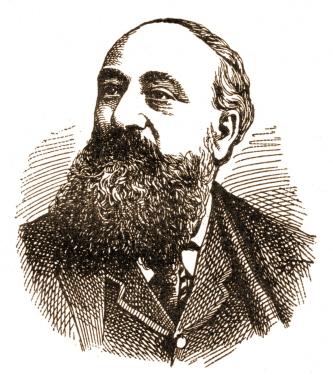
G.H.D. Gossip
Tim Harding (Dublin) comments that a specimen of Gossip’s signature given in the May 2001 BCM, page 265, ‘does seem to support the Hatfeild spelling’. He adds, further to the Gossip entry in Jeremy Gaige’s Chess Personalia (Jefferson, 1987), that the reference for the death certificate mentioned by Gaige is Petersfield 2c 84. Does any reader have a copy of the certificate?
As indicated in C.N. 5075, the ‘Hatfeild’ spelling became common usage after its appearance in The Oxford Companion to Chess in 1984. Earlier, the Companion’s co-authors had used ‘Hatfield’ on page 306 of the October 1964 BCM (D. Hooper) and on page 408 of the September 1979 BCM (K. Whyld). As noted in our feature article Gossip, it was Hooper who revealed, in 1964, where and when Gossip died (in Liphook, Hampshire, England on 11 May 1907).
C.N. 3384 quoted from page 33 of Morphy Gleanings by P.W. Sergeant (London, 1932):
‘I see no reason for the suggestion of some writers, including G.C. Reichhelm, that it was a case of suicide – by opening a vein, Reichhelm says.’
We are still seeking information on where Reichhelm, or any other writers, claimed that Morphy killed himself.
As noted on page 109 of our book on Capablanca, in June 1920 Lasker abdicated as world champion. A prime source for this information is page 126 of the July-August 1920 American Chess Bulletin, part of which is reproduced below:
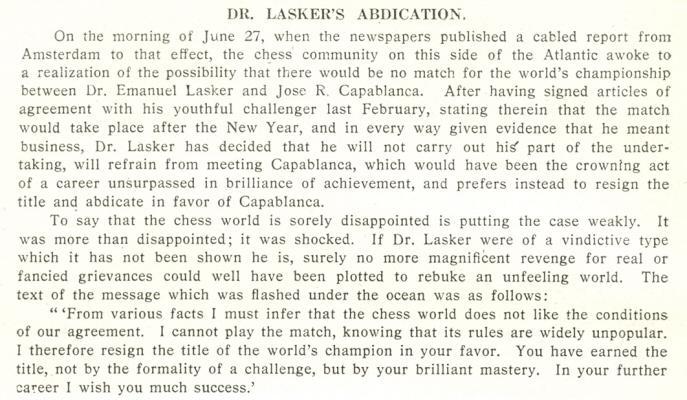
Javier Asturiano Molina (Murcia, Spain) notes that a slightly different wording appeared in Lasker’s letter of 18 June 1920 to Capablanca, written from the Hotel Stadt Elberfeld, Amsterdam. It was reproduced on page 214 of The Collected Games of Emanuel Lasker by K. Whyld (Nottingham, 1998).
David DeLucia (Darien, CT, USA) informs us that he owns a letter dated 17 June 1920 written by Lasker to his wife, from Huize Parkzicht in Amsterdam, in which he stated that he had resigned the world title that day. The document will be appearing in a book on Mr DeLucia’s collection which he is currently preparing.
Mr DeLucia also mentions that he owns one of the paintings of Lasker featured in C.N. 5071. This is another matter on which full particulars will be presented in his forthcoming book, but he has kindly authorized us to reproduce the illustration below:
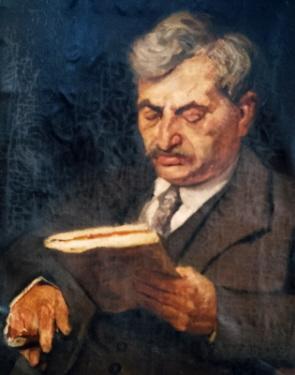
Milan Ninchich (Macquarie, ACT, Australia) enquires about the original price of the first Jaques club-size Staunton set (dated 1849) and asks what is known about the boxes which Staunton signed and numbered by hand.

We consulted the owner of The House of Staunton, Frank Camaratta (Toney, AL, USA), who is writing a book entitled The Staunton Chessmen and their Predecessors. Mr Camaratta has informed us:
‘The original plan was to have
Staunton hand-sign and hand-number 1,000 (or possibly 999) of
the manufacturer’s paper labels, which were affixed to the
bottom of the boxes of Jaques chessmen (wood, ivory, both
sizes), and it is known that he signed at least 600, as I have
seen specimens with numbering that high. Here is a label from
set number 488:
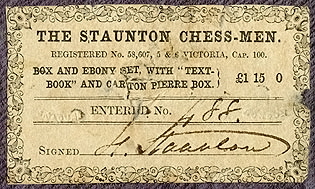
It shows the price of an unweighted boxwood and ebony set with a 3-3/8” king in a carton-pierre casket: £1 15s 0d.
The label below is from the large
club-size chessmen (4-3/8” king):
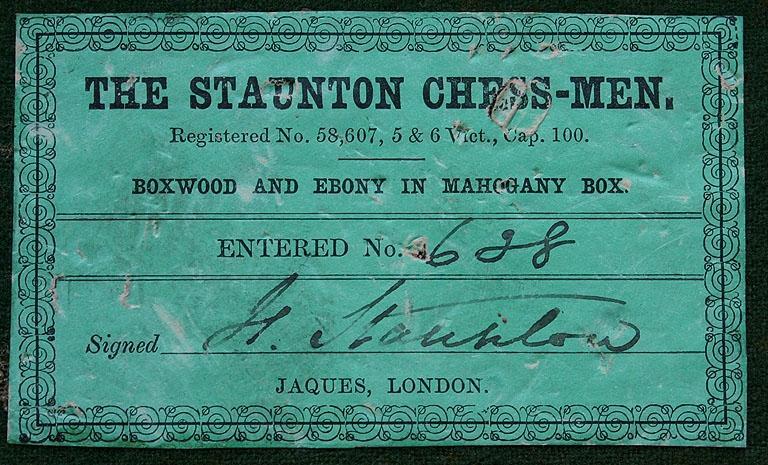
The price of the club-size set, loaded with lead, was £2 5s 0d. By contrast, the club-size set made from African ivory was £9 9s 0d in the extra-large carton-pierre casket and £10 10s 0d in a Spanish mahogany case with two partitioned fitted trays for the chessmen. I have seen hand-numbered labels as low as 10.
There was a series of numbered labels which followed, all having a facsimile signature of Staunton and a printed Entered (production) Number. The labels came in three colors: green, yellow and red. The green labels were found only on wooden sets, all sizes, in mahogany hinge-top boxes and were numbered from 1,000 (1,001?) to 1,999. I have seen labels numbered between 1,009 and 1,975. The yellow labels bore numbers from 2,000 to 2,999 and were found only on carton-pierre caskets which housed the smaller (2-7/8” and 3-3/8” kings) unweighted Jaques boxwood and ebony sets. The weighted sets (which were made only in the 3-3/8”, 4” and 4.4” king sizes) could not be housed in the carton-pierre caskets since they would “break through” the sides of those relatively fragile caskets. Finally, the red labels bore numbers from 3,000 to 3,999 and were reserved for ivory sets. Ivory sets were housed in carton-pierre caskets (of which there were three sizes), blue velvet-lined mahogany boxes and the large-fitted (Spanish) mahogany caskets. After that, the labels were not numbered.
There is also a story surrounding
the small green round registration stickers found under the
bases of the earlier Jaques chessmen.

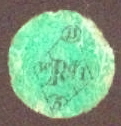
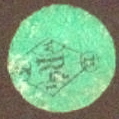
These gave the class and date of registration for the design. There were actually three designs, and not one as is commonly believed. Two had errors and may well become valuable. There was also a short run of early Jaques labels bearing the incorrect registration number.’
Readers may wish to note that Mr Camaratta has a new company, The House of Staunton Antiques, LLC. He has kindly supplied all the illustrations for the present item, including this final one:
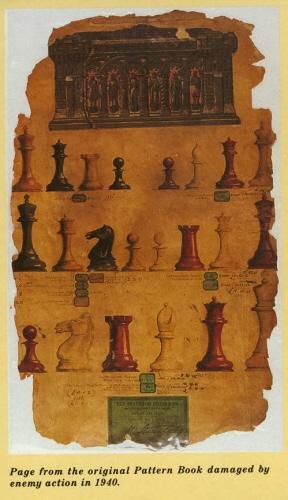
Thomas Binder (Berlin) asks what a ‘ticket tournament’ is. In the archives of his club (SF Siemensstadt) he has found references to Ticket-Turnier in reports from the 1950s and 60s, and he points out two webpages which refer to earlier such events in Berlin:
Do readers have any information? We wonder whether a ‘ticket tournament’ is the same as a ‘tombola tournament’, a term mentioned in our feature article The Saburovs.
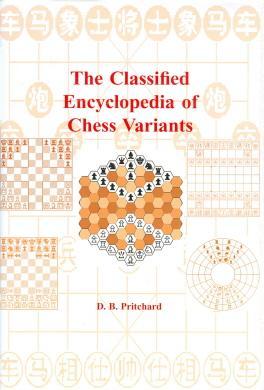
The Classified Encyclopedia of Chess Variants by D.B. Pritchard (Harpenden, 2007) is an updated edition of his 1994 volume The Encyclopedia of Chess Variants, having been ‘completed and edited by John Beasley’. We had extensive correspondence with the late David Pritchard as he prepared, over many years, his 1994 volume, and John Beasley justly notes on page 15 of the new Variants book that D.B.P. ‘stood head and shoulders above anyone else in this field’. For his part, Mr Beasley has carried out the editorial work in fine style, making this one of the best recent chess books.
Javier Asturiano Molina (Murcia, Spain) draws attention to a webpage on isolani by Olle Ekengren.

This photograph, with Capablanca standing third from the left, was given on page 209 of Chess Facts and Fables, but only in a small format, and we therefore show it here in a full-size version. It comes from The Columbian 1909, page 140.
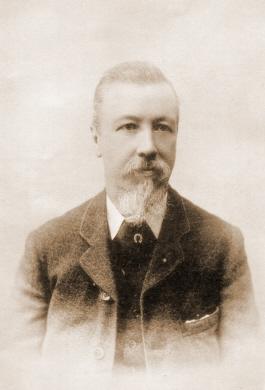
Joseph Henry Blackburne
Mario Ziegler (Neunkirchen, Germany) queries the statement in our feature article Chess in 1924 that J.H. Blackburne was born in 1841, and not 1842:
‘I was very surprised to read this, because I had in mind Blackburne’s own information, on page 214 of Mr Blackburne’s Games at Chess, that he gave his first blindfold exhibition in 1862 at the age of 19.’
Blackburne’s year of birth used regularly to be given as 1842, but 1841 is correct. Below is an item in D.J. Morgan’s Quotes and Queries column on pages 180-181 of the June 1963 BCM:


The unfortunate misprints in the dates (1941, 1942, 1941 all being a century out) were corrected by D.J. Morgan in the following issue (July 1963, page 219). CHESS and the BCM seldom mentioned each other, but B.H. Wood’s magazine took the opportunity for a little sarcasm. From page 282 of CHESS, 29 June 1963:
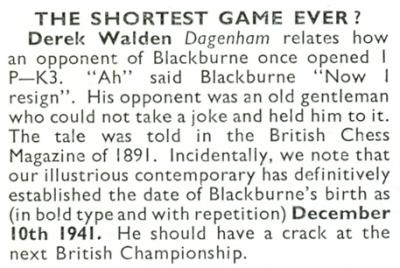
Page 1 of Mr Blackburne’s Games at Chess by P. Anderson Graham (London, 1899) stated:
‘He was born at Manchester on 10 December 1842 – the same year as that in which Staunton’s handbook was published ...’
This is doubly wrong, since the Handbook first appeared in 1847.
The Dover edition of the book, Blackburne’s Chess Games (New York, 1979), contained an Introduction by David Hooper which, on page vi, corrected the birth-date:
‘He was born on 10 December 1841, not 1842, as is stated at the beginning of Chapter I.’
See also the census information about Blackburne in C.N. 4756.
The photographs below come from the Gijón, 1944 tournament book, Torneo internacional de ajedrez by Juan Fernández R. Rúa (Madrid, 1945):
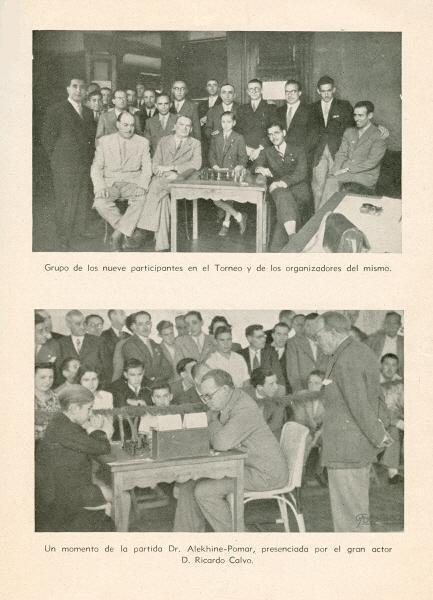

Jon Crumiller (Princeton, NJ, USA) sends the first advertisement for the Jaques Staunton set, on page 223 of the Illustrated London News, 29 September 1849:

Our correspondent also reports that he possesses a (framed) letter written by Staunton on 8 August 1847 (and headed ‘Chess Champion’):
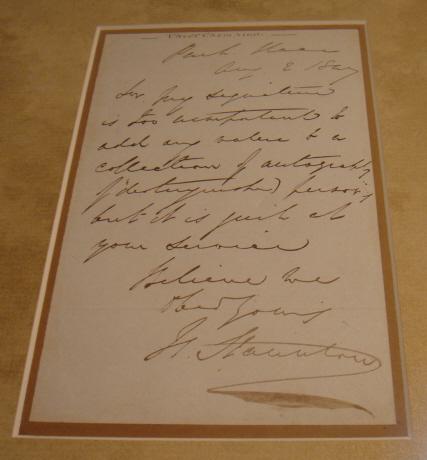
The body of the letter reads:
‘My signature is too unimportant to add any value to a collection of autography of distinguished persons but it is quite at your service.’
Catherine Glynn (Southampton, England) asks for information about the chess writer and poet Henry Thomas Bland.
Pages 197-198 of Kings, Commoners and Knaves and page 396 of A Chess Omnibus quoted three of his poems (attempted tributes to Menchik, Bogoljubow and Kashdan). Another example of his way with words is the start of ‘Internal Fires’, a poem published on page 57 of the March 1930 American Chess Bulletin:
On page 81 of the May-June 1929 Bulletin his work even received star billing:
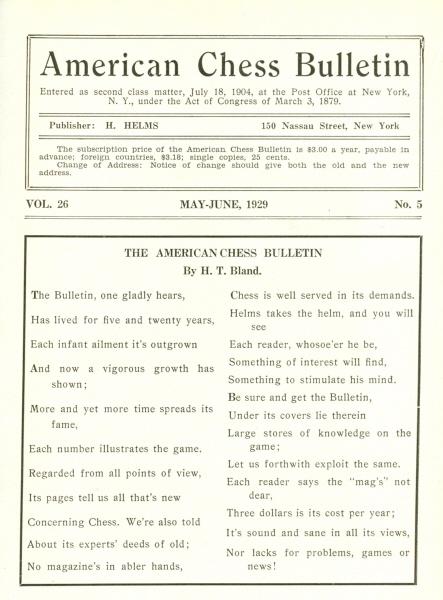
The Bulletin published many other specimens of his dodgy dogged doggerel, and his prose contributions included an inconsequential feature on Blackburne (March 1929, pages 46-47) and two brief, vapid sets of ‘Chess Memories’ (March 1930, page 51 and April 1930, page 75). That year Bland produced a compilation of his verse and prose, under the title Chess in Lighter Vein. Dishearteningly, the 48-page brochure was welcomed not only by the Bulletin (September-October 1930, page 154) but also by the BCM (August 1930, page 280). The self-publication was available from Bland at 25 Harvey Road, Wallasey, Cheshire, England.
On page 184 of the November 1931 Bulletin Bland referred to ‘my late brother, Mr W.R. Bland’ having been responsible for chess problems in the BCM under the magazine’s first editor, John Watkinson.

Henry Thomas Bland, American Chess Bulletin, September-October 1932, page 147
H.T. Bland died in 1932. Jeremy Gaige’s Chess Personalia (private 1994 edition) states that he was born in Belper [Derbyshire], England in the first quarter of 1858, and from the records available at the Family Search website we take him to be the Henry Thomas Bland who was born on 3 March 1858 and christened in Duffield, Derby on 30 April. (His elder brother, William Robert, died in Duffield in 1929; see the BCM, April 1929, page 132.)
If that information is correct, the American Chess Bulletin misstated H.T. Bland’s age (‘70 years of age when he died’) in the obituary published on page 147 of its September-October 1932 issue. Following details supplied by his brother-in-law, Mr A. Dalby of South Hill Park, London, the Bulletin added that Bland ‘was born near Derby and worked in the secretary’s office on the Midland Railway. ... After his retirement from the railway some years ago, he had lived in Southport and London’. It may, though, be wondered whether ‘Southport’ is correct, since Gaige lists him as having died in Stockport.
The Bulletin recorded that Bland died a few days after attending the chess congress in Cambridge. We note that he played in the Second Class tournament there, finishing last with a score of +1 –7 =0 (BCM, May 1932, page 196).

Isidor Gunsberg
Among the leading chess masters of the past, one stands out as particularly difficult to grasp in terms of personality and character: Isidor Gunsberg (1854-1930). He is the only world championship challenger on whom no book has been written, and there is even a dearth of ‘human’ articles. Do readers know of any little-known ones which shed light on him?
‘One of the best photographs ever taken of Frank James Marshall’ was the comment on page 26 of the February 1931 American Chess Bulletin regarding this portrait:
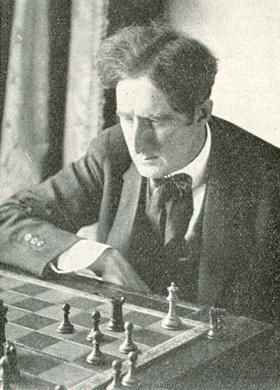
Frank James Marshall
However, Marshall is shown examining an incorrectly-set board. It would not seem to be a photograph mistakenly reversed, given that he customarily parted his hair on the left.
Firstly, we reproduce C.N. 1678:
From P.C. Wason:
‘Who was Baron Döry? What are the details of the tournament designed to test his defence (Vienna, 1937)? And what are the details of his resistance to the Nazis which led to a sentence of death which was not carried out?’
Perhaps a reader would care to deal with the biographical matters raised by our correspondent. Articles about the Döry Defence (1 d4 Nf6 2 Nf3 Ne4) appeared in the Wiener Schachzeitung of. October 1936 (pages 293-295) and December 1936 (pages 359-360), the writers being Immo Fuß and Ladislaus Baron Döry respectively. The features were the subject of brief items in the BCM of January 1937 (page 22) and March 1937 (page 140).
The May 1937 Wiener Schachzeitung carried a report on the Döry Defence tournament, held in the Café Central, Vienna on 19-26 May. Keres, Weil, Becker and Podhorzer (order of finish) played two games against each other. From the many games from the event which the Wiener Schachzeitung published, we pick the following:
1 d4 Nf6 2 Nf3 Ne4 3 Nbd2 d5 4 g3 c5 5 dxc5 Nxc5 6 Bg2 Nc6 7 O-O e5 8 c4 d4 9 b4 Nd7 10 b5 Na5 11 Ne1 Be7 12 f4 exf4 13 Rxf4 O-O 14 Rf1 Ne5 15 Bb2 Bg5 16 Nc2
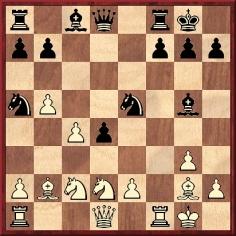
16...d3 17 exd3 Nxd3 18 Bd4 Nb4 19 Nf3 Nxc2 20 Qxc2 Be6 21 Rad1 Bxc4 22 Bc5 Qc8 23 Qf2 Bd8 24 Rxd8 Rxd8 25 White resigns.
Source: Wiener Schachzeitung, June 1937, pages 173-174.
Stefan Bücker (Nordwalde, Germany) now writes:
‘More on the Döry family is available on pages 11-12 of the January 1915 Wiener Schachzeitung, but the most interesting find has been on the Internet. A webpage of the Dokumentationsarchiv des österreichischen Widerstandes has photographs of the Baron and affirms that he was executed during the Second World War:
“Der Konzertpianist und Komponist Ladislaus Döry von Jobbahaza (geb. 1897) erklärte im privaten Kreis 1940 unter anderem, dass das wirtschaftliche und kulturelle Leben Österreichs im Absterben begriffen und Hitler ein machtgieriger Despot sei. Von den Eheleuten Graf Seilern denunziert, wurde er wegen Wehrkraftzersetzung zum Tode verurteilt und hingerichtet.”
However, the entry on “Döry Defence” in The Oxford Companion to Chess (page 112 of the 1992 edition) states:
“... pioneered by Ladislaus Döry, an Austrian Baron, in 1923 … In 1943 Döry was sentenced to death by the Nazis for sedition, but was released from prison by Allied troops in 1945.”
The two sources contradict each other as to whether or not Döry survived the War.’
We note that page 177 of the 1994 edition of Jeremy Gaige’s Chess Personalia indicates that the Baron was still alive in 1947. Reference is made to a source not in our collection: ‘Schachspiegel, 1947, page 124’.
From Christian Sánchez (Rosario, Argentina):
‘During the Capablanca v Alekhine world championship match Tartakower wrote an article on page 10 of the 31 October 1927 edition of La Prensa. He expressed confidence in Alekhine by mentioning an earlier article of his own (Magyar Sakkvilág, April 1927) in which he had stated that the match was more justified than ever and would not be one-sided:
“A fin de no aparecer influenciado por la situación actual de la misma [la lucha], citaré a los lectores de La Prensa mi artículo publicado en el número de abril de este año de la publicación Magyar Sakkvilág, en la que, después de preguntar si el ‘match’ Alekhine-Capablanca conservaba aún su razón de ser, expresaba mi opinión de que entonces más que nunca.”’
Could a reader provide Tartakower’s article in Magyar Sakkvilág?
Our correspondent notes that elsewhere in his report in La Prensa Tartakower mentioned Spielmann as one authority who had predicted that Alekhine would not win a single game in the Buenos Aires match.
Mr Sánchez also provides an article by Hartwig Cassel (1850-1929) on page 2 of section 3 of the 21 August 1927 issue of La Prensa, although it was written in June (in New York). Cassel reported that in the opinion of the New York chessplayers the Capablanca v Alekhine match would not be of interest, as Capablanca would win easily. He stated that, on the basis of recent tournament results, Lasker and Bogoljubow had a greater right to challenge the Cuban, as Alekhine lacked the requisite stature for the match.
The article was unfortunate too not only in misspelling Cassel’s name on both occasions it was mentioned but also in claiming that in a game between Capablanca and Alekhine at New York, 1927 the following position had arisen ...

... and that Capablanca had played 1 Nd3, the game being drawn a few moves later. Instead, wrote Cassel, 1 Nc6 Bxc6 2 Rxc6 would have caused the loss of Black’s a-pawn, after which Capablanca might well have won the game.
In reality, the above position never occurred, as Alekhine pointed out on page 29 of the February 1928 American Chess Bulletin:
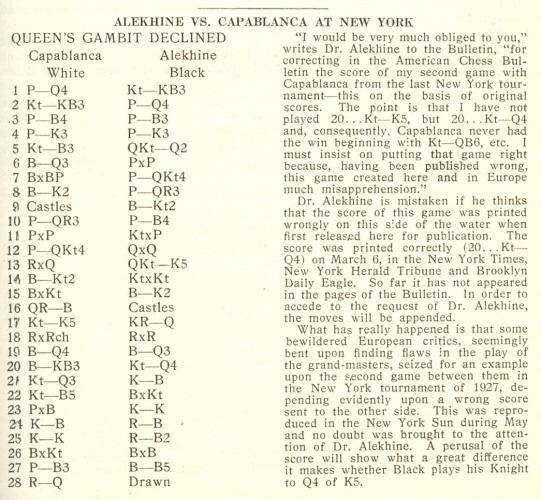
The New York Sun (mentioned by the Bulletin) had as its chess columnist Hartwig Cassel.
On page 97 of his book on New York, 1927 the explanation offered by Alekhine was that a telegraphic error had resulted in 20...Ne4 being given, instead of 20...Nd5, in South American and European chess magazines:
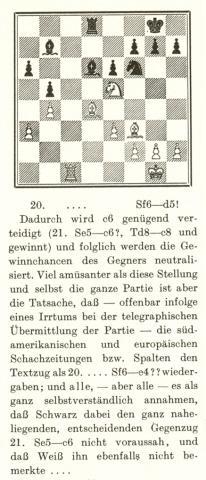
For an English version of the note, see page 308 of the Skinner/Verhoeven book on Alekhine.
Finally, page 117 of the July-August 1929 American Chess Bulletin had a photograph taken at Bradley Beach, 1929 which featured both Alekhine and Cassel. The latter died about a month afterwards.

The person between Herman and Lajos Steiner is not identified.

A very rare book published in Buenos Aires in 1994, Match por el campeonato de ajedrez Capablanca y Alekhine, reproduces about two dozen letters and telegrams exchanged by the two masters and the organizers, and an item of particular interest is a letter written on 18 October 1927 by Alekhine, in French, on stationery of the Majestic Hotel, Buenos Aires. The recipient was the President of the Club Argentino de Ajedrez, Lizardo Molina Carranza, to whom Alekhine complained of having read in the morning’s newspapers that game 17 would be played at the Jockey Club. Refusing to accept this, Alekhine commented that the previous day game 16 had been played there under conditions contrary to the spirit and letter of the match rules. In view of the unbearable noise in adjoining rooms, Capablanca had been obliged to stop his clock, thereby breaking off the game (an occurrence ‘probably unique in the annals of the world championship’). Finding mental effort impossible in such circumstances, Alekhine had accepted Capablanca’s draw offer despite having the better position.
The two key paragraphs in Alekhine’s letter are given below, with some corrected spelling:
‘A. Mon adversaire, vu le bruit insupportable qui régnait dans les pièces adjacentes à celle où se jouait la partie, se vit obligé à arrêter la pendule, suspendant ainsi de propio avisu [sic] le jeu, chose probablement unique dans les annales des championnats du Monde.
B. Moi-même ne vis d’autre solution pour sortir de cette atmosphère hostile à tout travail mental, que d’accepter la nullité proposée par mon adversaire, dans une position que je considérais avantageuse pour moi et qui, en tout cas, aurait pu donner lieu à une lutte sérieuse et prolongée.’
It may be recalled (see C.N.s 824 and 861) that it was in connection with game 16 that the story arose of Capablanca falling asleep at the board. For example, on page 44 of Le match Capablanca Alekhine (Brussels, 1929) V. Soultanbéieff commented that, according to the United Press, this had occurred while Alekhine was reflecting on his 19th move and that Capablanca was not awoken by the match director until it was his move. A footnote on the same page stated that Alekhine had denied the sensational story.
Alekhine subsequently wrote about the matter in Auf dem Wege zur Weltmeisterschaft (Berlin and Leipzig, 1932), and here we quote the relevant passage from page 178 of the English edition, On the Road to the World Championship 1923-1927 (Oxford, 1984):
‘My decision to agree a draw so early is explained only by the quite unusual circumstances in which this game took place. In fact we were playing in the Jockey Club, not the usual venue, and it was so noisy there that we were forced to adjourn at move 24, i.e. even before the time control, in order to allow time for things to calm down. Later on, however, I was no longer in the mood for deep thought, and the game was agreed drawn without further ado.
Incidentally, the above lines may serve to show that the report that my opponent “fell asleep” during this game was nothing more than the invention of some witty newspaper man.’
We wonder whether any of the above has a bearing on C.N. 2403, which quoted an alleged incident reported on page 140 of the September 1928 Schweizerische Schachzeitung, in an account of the FIDE Congress in The Hague on 2 August. Below is our translation:
‘During one game in the world championship match, Mr Capablanca, who had the move and sufficient time in reserve, ventured to go into an adjoining room, leaving his clock running, in order to analyse the position in depth; this he did for an hour, on his pocket board. Since this case was not covered by the Regulations, the arbiter had no power to intervene. That power is now recognized: players must, except in case of absolute force majeure, remain under the surveillance of the arbiter.’
Jan Kalendovský (Brno, Czech Republic) has been trying to identify all the figures in the group photograph of Marienbad, 1925:

He offers the following:
‘Seated (left to right): N.N., A. Nimzowitsch, R.P. Michell, A. Rubinstein, I. Gunsberg, N.N., V. Tietz, Sir George Thomas, D. Janowsky, F.J. Marshall, F.D. Yates
Standing: L. Burian, H. Kmoch(?), M. Walter, C. Torre, N.N., D. Przepiórka, R. Spielmann, R. Réti, E. Grünfeld, F. Sämisch, S. Tartakower, A. Haida, K. Opočenský.’
The photograph appeared at the start of the tournament book, with the caption ‘Tournament participants and guests’ (‘Teilnehmer und Gäste des Turniers’). Mr Kalendovský reports that it was originally published in the Wiener Bilder, 7 June 1925.
C.N. 4329 referred to the famous remark about an isolated pawn spreading gloom all over the chess board, a ‘Tartakowerism’ so often seen on the Internet without any source.
Hassan Roger Sadeghi (Lausanne, Switzerland) points out that the remark appeared on page 113 of the second edition of Tartakower’s book Schachmethodik (Berlin, 1929):
‘Ein isolierter Bauer verbreitet Trübsinnigkeit übers ganze Brett.’
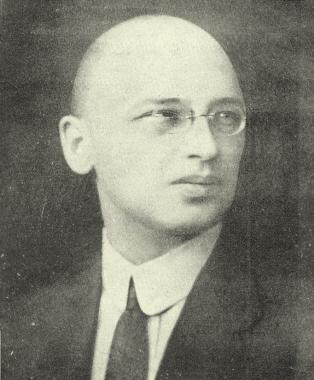
Savielly Tartakower
C.N. 4868 quoted from page 63 of the August 1898 American Chess Magazine regarding Tarrasch:
‘“It is not sufficient to be a good chessplayer, one must play good chess”, is one of his favorite sayings.’
The reporter was Armin Friedmann in Pester Lloyd, 20 or 21 June 1898. The original German version was given on page 346 of the Vienna, 1898 tournament book:
‘“Es ist nicht genug, dass man ein guter Spieler ist, man muss auch gut spielen”, lautet einer seiner Aussprüche.’
In C.N. 4877 a correspondent referred us to the following on page 206 of Tarrasch’s Dreihundert Schachpartien (Leipzig, 1895), regarding his poor performance at the Leipzig, 1888 tournament:
‘Ich glaubte, es genüge vollkommen, mich ans Brett zu setzen und Züge zu machen, um zu gewinnen ...
Our translation:
‘I believed that to win it was quite sufficient for me to sit down at the board and make moves ...
... I recognized that it is not enough to be a good player, but that one must play well.’

Siegbert Tarrasch
Now we note the following in an ‘Interview with Dr Tarrasch’ on pages 196-198 of the Chess Player’s Chronicle, 20 September 1890 (an article originally published in the Birmingham Daily Gazette):
‘In 1888 he won first prize in the German Masters Tourney at Nuremburg, but failed to obtain a place in the Leipsic Congress. He says, “I found myself underrating my opponents and underplaying myself. It is not enough to be strong; you must put your strength into your play”.’
The interview closed with another notable remark from Tarrasch:
‘I get no first-class play in Nuremburg, and the less I practice the better I play.’
From Stefan Bücker (Nordwalde, Germany):
‘The requested article about Baron Döry on page 124 of Schachspiegel, 1947 has kindly been provided by Peter Anderberg and Michael Ehn.
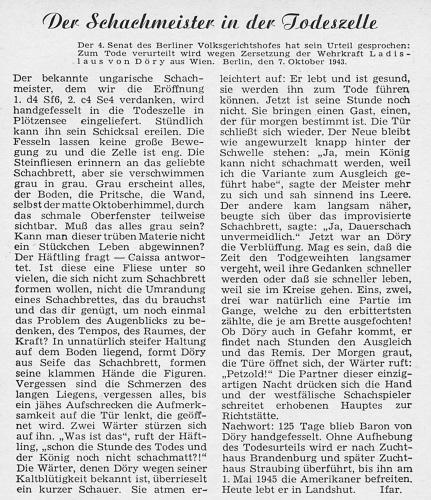
It states that Baron Döry was sentenced to death for sedition in Berlin on 7 October 1943. His hands bound, he spent 125 days in a death cell at Plötzensee. Without abrogation of his capital sentence, he was subsequently taken to other prisons (Brandenburg and Straubing), and on 1 May 1945 he was released by American troops.
I have incorporated this and other information about Döry into my new article ‘Ahead of his Time: Ladislaus Baron Döry.’
Jon Crumiller (Princeton, NJ, USA) recalls a passage on page 205 of The Life and Games of Mikhail Tal by M. Tal (New York, 1976). It comes from Tal’s note to his 28th move (...Bf4) against Botvinnik in game six of their 1960 world championship match:
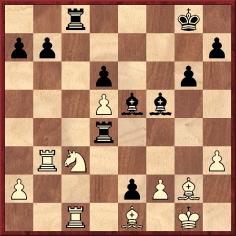
‘Unfortunately Black missed a possibility to end the game quickly and beautifully by 28...RxN! 29 R(3)xR R-Q8 30 R-B4 B-N7. Of course there were more than chess reasons for this: the noise in the auditorium had prompted the referees of the match to carry out their threat and move the game to a closed room. This of course turned to be an extremely severe warning to the spectators and in the following games there was no need to take such measures, but one does not feel very pleasant when, with an hour remaining on the clock, one is politely asked to move into the wings in the very heat of battle ... in any case, I am not used to playing in “nomadic” conditions.’

From Ola Winfridsson (Cambridge, England):
‘The photograph could be correct. It looks as if the board folds in the middle, and I assume this to be between the fourth and fifth ranks rather than between the d and e files. It all depends on the original shade of the squares of the chessboard; in some old black and white photographs and films, lighter colours appear darker than darker colours.’
Alan McGowan (Waterloo, Canada) mentions that a key to the Marienbad, 1925 group photograph was published on page 89 of the May-June 1925 American Chess Bulletin. The additional information it supplies is:
From page 129 of the July-August 1929 American Chess Bulletin:
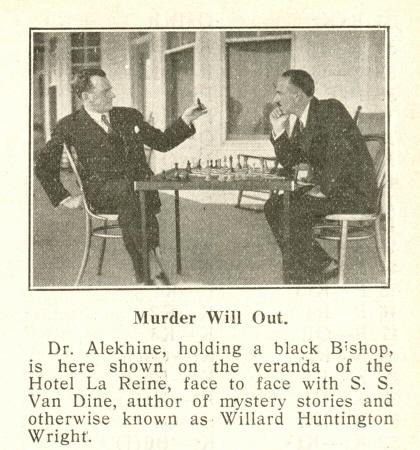
‘Be more considerate to small boys.’ That request was made to Alekhine by Gerald Abrahams in 1936, as related on pages 135-136 of his book Not Only Chess (London, 1974).
At a simultaneous display in Liverpool in autumn 1923 Abrahams, then aged 16, was the last surviving player:
‘And there was Alekhine, standing over the board, insisting on instantaneous replies. He thought, then made his move, rapped sharply on the table and made impatient sounds in Russian.
The position was hard. Pawns wedged with pawns, and my king bishop and knight, endeavouring to be on guard at all moments against his king, and two fantastically wheeling knights. After 12 lightning moves under these conditions the boy went wrong, found a pawn indefensible, and resigned. The grandmaster swept the pieces aside brusquely, and stalked away. He was, let me emphasize, entirely within his rights.’
After describing how differently Capablanca later behaved towards him in similar circumstances, Abrahams related that at Nottingham in 1936 Alekhine’s wife (‘a delightful American lady’) required assistance with a visa renewal.
‘Alekhine asked me to oblige, and I gladly did so. He said, “If I can ever do anything for you, please ask me.” I replied, “You can do something for me.” He raised an interrogative eyebrow. I said, “Be more considerate to small boys.” The frozen blue eyes stared at me for some seconds. “Yes”, he said, I remember, Liverpool 1923. You had pawns, bishop and knight against my pawns and two knights. You should have drawn that game.”’
Although Abrahams stated that Alekhine faced 60 opponents, the master’s score given on page 403 of the November 1923 BCM and page 197 of the Skinner/Verhoeven book on Alekhine was +24 –1 =6. The exhibition took place on 29 September 1923.

Gerald Abrahams
C.N. 3397 gave a picture of Labourdonnais by Sam Loyd (Scientific American Supplement, 6 April 1878, page 1884) and we commented:
‘This is based on the well-known (and only known) picture of the Frenchman, and Loyd wrote, “our portrait is taken from an oil painting made in London a short time before his death”.
This brings to mind Staunton’s remark on page 159 of the Chess Player’s Chronicle, 1842 when welcoming the French magazine Le Palamède:
“We must, however, protest against the insertion of such lugubrious twaddle as ‘The last moments of Labourdonnais’, from – Bell’s Life in London! and the lithographic enormity, from the same classic source we presume, presented as the portrait of that distinguished chessplayer.”’

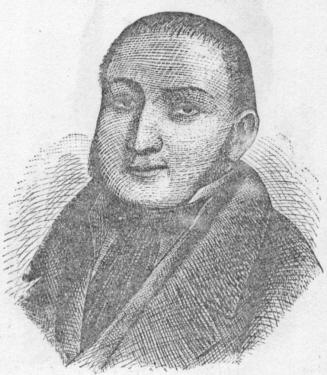
Loyd’s picture (above, on the right) was also given on pages 286-287 of Chess Facts and Fables, but what is the exact connection between the ‘oil painting’ and the ‘lithographic enormity’? We also wonder how they relate to the slightly different picture of Labourdonnais in Loyd’s ‘photographic chessboard’ (C.N. 3590). That illustration sometimes appeared, again in minuscule form, in headings in the Chess Amateur (e.g. July 1913 issue, page 290):
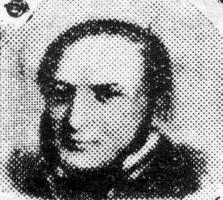
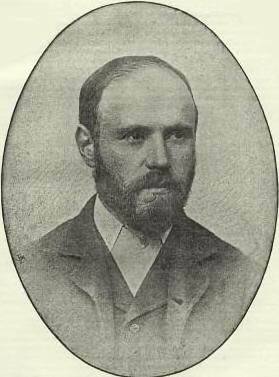
Isidor Gunsberg
From Elizabeth Tansley (Taunton, England):
‘His obituary in the London Times states that I. Gunsberg was born in Budapest on 2 November 1854 and died on 2 May 1930. [1] It makes no mention of a wife or family, but Gunsberg appears to have married three times – to Jane, Miriam and Agnes.
Jane [2] died, aged 38, at Wandsworth in 1891, shortly after the census. She was listed as Isidor’s wife in the 1881 census, and it seems likely that their marriage took place in London in 1879 [3], where his name is spelt Isidore Gunzberg in the index. Jane is probably Jane Isaacs. Three of their surviving children are in the 1891 census: Alfred (1884) [4], Herbert (1886) [5] and Lionel (1887) [6].
Isidor remarried as Isidor Arthur Gunsberg in 1893 [7] at St Giles, London to Miriam Clarke. She died [8], aged 39, in 1897 at Barnet, having given birth to two daughters, Grace Winifred (1894) [9] and Miriam (1896) [10], both of whom are in the 1901 census.
Having now five children to look after, he remarried [11] in 1898 at Lambeth to Agnes Ramage, recorded as Agnes Jane in the 1901 census. They had a daughter, Kathleen Ramage Gunsberg [12], in the 1901 census, aged two months. Isidor was now 46 years old and Agnes 38.
He became a naturalized British subject [13], under the name of Isidor Arthur Gunsberg of 14 Honeybrook Road, Balham, taking the Oath of Allegiance on 12 May 1908 [14].
On 13 December 1916 Gunsberg was successful in suing Associated Newspapers and the Chess News Agency for libel, winning £250 in damages. The report of the action in The Times [15] contains some interesting facts, namely that his father was a Russian Pole and that Gunsberg had been brought to England in 1862, aged eight. At the time of the trial he had been chess editor of the Daily Telegraph for 26 years.
On 20 July 1923 [16], giving his address as 14a Lunam Road, Upper Norwood SE19, he filed for bankruptcy at the High Court. The bankruptcy was not finally discharged until 17 April 1930 [17] in the month before his death.
Sources:
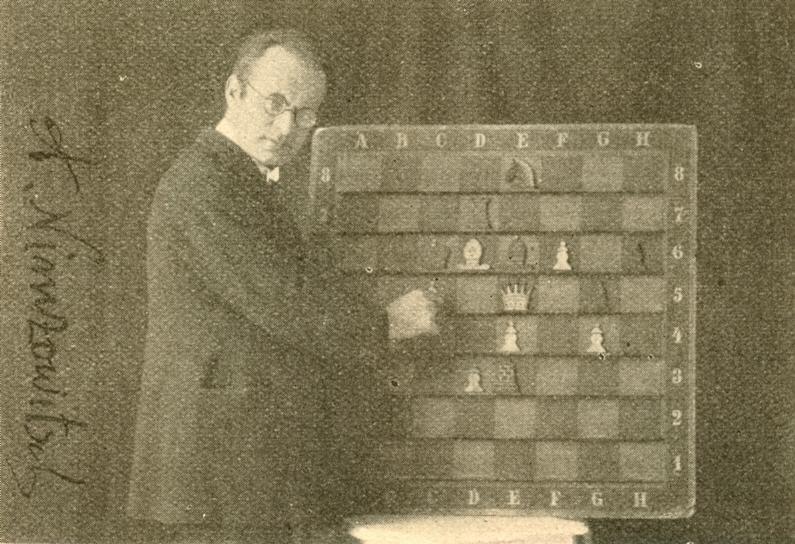
This photograph was published on page 10 of the American Chess Bulletin, January 1927. Does the board position come from a known game?
Who is this chess writer and historian?
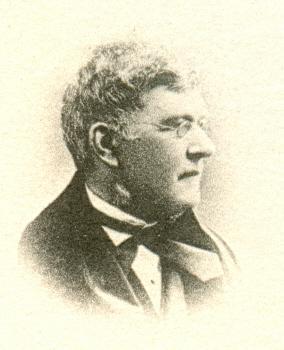
Regarding The Knight Challenge, Pablo S. Domínguez (Madrid) points out Emanuel Lasker’s unusual explanation which appeared on pages 5-6 of Lasker’s Manual of Chess (New York, 1927), as well as in later editions of the book:
‘... the knight jumps in making the shortest move that is not a straight one.’
The corresponding text in the earlier German edition, Lehrbuch des Schachspiels, reads:
‘... der Springer macht einen Sprung, nämlich den kürzesten auf dem Schachbrett möglichen Zug, der nicht gerade ist.’
The English volume (page 10) also had this description of the knight’s move:
‘The shortest jump on the chess board is, namely, to take two squares (in the air) in a line or row and one square perpendicularly thereto.’
From Jeremy Spinrad (Nashville, TN, USA):
‘The term “ticket tournament” was sometimes used to refer to continuous tournaments in Brooklyn. Players would buy tickets for a small fee, and the loser of a game would put a ticket in a lockbox, with a record of the winner and loser of the game. At the end of the tournament, i.e. after several months, there were prizes for the players with the best winning percentages. The following reports appeared in the Brooklyn Daily Eagle:
| First column | << previous | Archives [37] | next >> | Current column |
Copyright 2007 Edward Winter. All rights reserved.